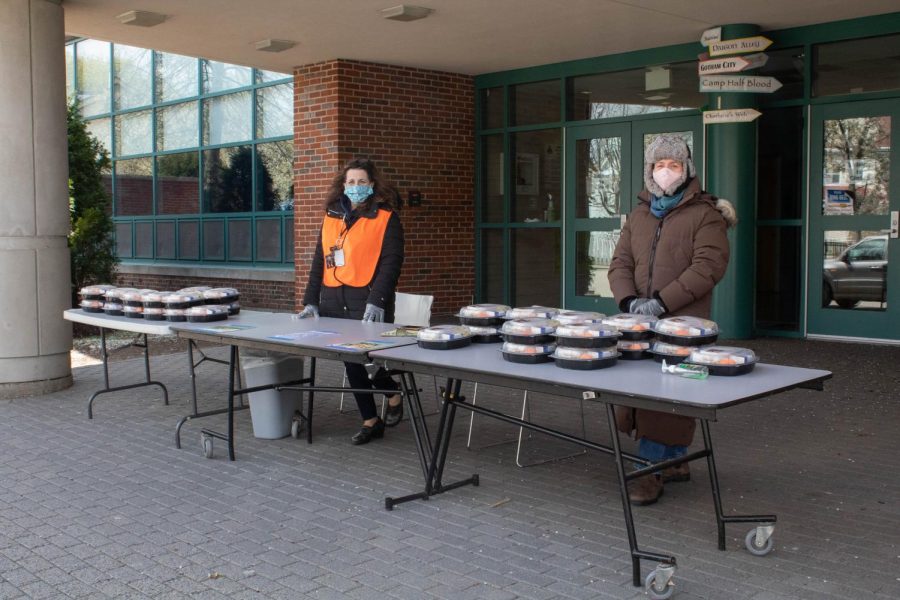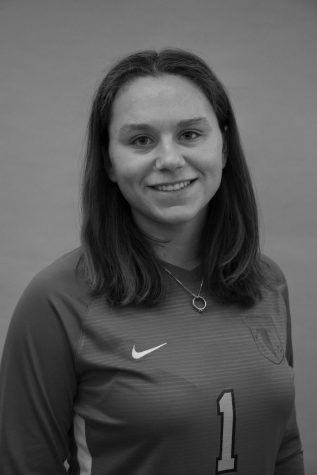Cambridge Principals Reflect on the Daunting Task of Transitioning to Distance Learning
Pictured: One of the district’s meal distribution centers.
April 30, 2020
As the student body of Cambridge Public Schools has settled into taking courses online using such means as Google Classroom or video call platforms like educator favorite Zoom, and have been forced to adjust to fewer distinctions between work and personal life, the school and district leaders throughout Cambridge have been hard at work making remote school a reality in the time of COVID-19. In the five weeks since the virus forced CPS to close its doors, the district allocated resources to distributing Chromebooks to students in grades 3 through 8, providing hotspots for families who don’t have reliable WiFi, launching emergency meals programs that has already given out 20,000 meals, but, most significantly, has transitioned all of Cambridge’s 6,539 students to an entirely digital model of teaching and learning. In an interview with the Register Forum, Superintendent Kenneth Salim pointed out that in typical circumstances, a shift this large would “take months, if not years to plan out.” Instead, he continued, it had to happen “at the flip of a switch,” and as a consequence of this condensed timeline, “there’s an enormously steep learning curve for students, for educators, for families.”
The district’s 20 principals have been at the forefront of making this transition possible even as their own lives have been upended. Several of Cambridge’s principals are parents themselves, which increases the hardship they are facing. “Everything is blurred because I’m working from home, but, also, my children are here and need to be educated and cared for,” said CRLS principal Damon Smith, who spoke to the Register Forum while also supervising one of his sons who was doing an online math lesson. “It’s hard. It’s a time management nightmare.”
The catch-22 of the transition to distanced learning is that figuring out an entirely new model of remote education requires more time and creativity from educators—they now have to think about their jobs in entirely new ways at exactly a moment when, as Ms. Heidi Cook, the principal of Baldwin, noted, their “capacity is really stretched.”
In addition to having to learn new ways to manage their time, principals have had to figure out what it means to be a leader when they are not interacting with students and when they are meeting with staff virtually. Mr. Daniel Coplon-Newfield, principal of Vassal Lane Upper School, explained that it has been hard to be responsive to teachers’ needs when he can’t see them in person, saying that he has also been evaluating what it means “to have collaborative problem solving when you’re on a Zoom meeting—teachers aren’t really used to that.”
Another defining characteristic of a principal’s role is interacting with students, something they can’t do nearly as much without physical school. “My interactions now are almost exclusively with adults, whereas previously, on a regular school day, most of my interactions are with children over the course of the day,” noted Principal Chad Leith of Morse. Principal Nancy Campbell of Haggerty concurred and feels that not seeing students has been one of the biggest adjustments she’s had to make. She noted that, before the closure, “Every morning, my assistant principal and the family liaison [and I] stand outside starting at 7:15 and we greet everybody. We really get to see people and have this personal connection.” She continued, “It’s been really chaotic and hard ’cause my role first and foremost is to see kids and hopefully have kids feel like they’re seen in return … That’s the hardest part: not having the personal connection.”
Despite these changes, principals don’t believe that their primary purpose as school leaders has changed since schools were physically in session. “In many ways, it’s no different,” Ms. Campbell said. “I have this job to make sure that the systems and structures are in place to support teachers to do their best work for students … So, now, the job is really to create systems and structures to try and put that in place under [these new] circumstances.”
As they began to work on a new virtual design for teaching and learning, the first question the district and its principals needed to answer was what kind of engagement they needed to prioritize. Ultimately deciding that focusing on social-emotional connections between students and staff was the most critical element they needed to supplement. At Haggerty, Ms. Campbell explained that one of the first actions her school took was to assign every staff member three to five students to reach out to every week so that students were being contacted by at least one other person in addition to their classroom teachers. At Vassal Lane, Mr. Coplon-Newfield emphasized that distance learning “needs to prioritize social contact, almost over everything else, including content” because students are “missing that important opportunity to do all that socializing that they do in school,” so his teachers have been making sure to facilitate check-ins and ‘how are you’s’.”
Providing virtual face-to-face contact is especially important to young elementary school students, helping alleviate any anxiety during this uncertain time. “There’s something about a young child being able to see me or see the assistant principal or see their teacher or see their librarian or their gym teacher and go ‘Oh, there you are. You’re okay,’” Ms. Campbell said. But since kindergarteners, first-graders, and second-graders have not received Chromebooks yet (the district has ordered them but they are back-ordered), this face-to-face kind of contact on online platforms is not yet possible on a systemic level, something that concerns principals.
Principals are also learning to find the perfect balance between pushing out too much information and activities and providing too few of these resources. Ms. Campbell called this question the “Goldilocks test”—she and her staff are constantly asking families if what they are getting from the school is “too much, too little, or just right.” Families’ answers to the Goldilocks test, however, range somewhat as some families feel that given the new stressors they are dealing with, teachers are sending too much work for their students and for themselves to keep up with, but others are worried that their students won’t learn all the standards they need to to be prepared for next year and so are asking for more assignments. This range is a reflection of the many realities that Cambridge families are facing at this time. Ms. Campbell made clear that she does not want families to feel as though they are “failing” their children if they can’t fully commit to homeschooling them. “I don’t want parents to feel like there’s this expectation that every aspect of every assignment gets done—they’re not teachers and many of these parents are working themselves, so that’s a huge ask. I want to be realistic that we gotta be in this together.”
While it is impossible to know exactly what will happen in the future, principals acknowledge that this emergency closure period will have significant impacts on their students next year and beyond. Mr. Coplon-Newfield noted that if students don’t come back this school year, next September will look dramatically different than it would have without COVID-19. “We’ve had a massive interruption of learning and a pretty significant exacerbation of achievement and opportunity gaps for kids and so I think we’re going to really have to think about—probably content by content—what does that mean for students,” he said.
In particular, this closure has the potential to widen the achievement gaps even further between the district’s most vulnerable and its most privileged. Away from the equalizing influence of public school, students’ educations now depend much more on their individual family’s situations and the resources they have. “We know that the most marginalized are already farther behind to begin with and, yes, this compounds it,” Ms. Campbell said.
Principals are concerned about the closure causing an extreme summer slide (a term used in education to refer to students losing some of the skills they learned the previous year over summer break) where, as Ms. Bartel-Marrero, the principal of Amigos, said, students fall back to where they were three, four, five, six months prior.” Some of the students whose educations will be most impacted by this extended summer slide are the kindergarteners and first-graders learning to read. “I definitely lose sleep over our most vulnerable students. I think about the kindergartener, the first-grader who was just about to take off with their reading, and if they stop reading for six months, that impact will certainly be felt,” Ms. Bartel-Marrero said.
But still, CPSD principals recognize the silver linings that have come out of this crisis. Some think that students will learn to be more independent because of the closure. All are proud of the creativity and dedication to their students that their teachers have displayed and still others feel that in some ways, their school communities will come back stronger. Principal Heidi Cook of Baldwin noted, “I worry about the cohesiveness of our school community a little bit and then other times I think, ‘Wow, this is actually pulling us together in a totally different way and adds a new facet of strength to our school community.’”











